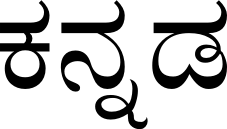Language/Kannada/Grammar/Conjuncts
| ◀️ Consonants — Previous Lesson | Next Lesson — Numbers ▶️ |
Welcome to your Kannada learning journey! In this lesson, we will delve into the fascinating world of Kannada conjuncts. Conjuncts are a crucial aspect of Kannada grammar, as they are used to combine consonants and thus create a smoother flow in writing and speech. Understanding conjuncts will not only enhance your reading and writing skills but will also help you to understand spoken Kannada better.
In Kannada, conjuncts are formed when two or more consonants come together. This differs from English, where consonants are typically pronounced separately. Learning how to recognize and pronounce these conjuncts will give you a significant advantage in mastering the language.
In this lesson, we will cover:
- What are Kannada conjuncts?
- How to pronounce conjuncts
- How to write conjuncts
- Examples of common conjuncts
- Practice exercises to apply your knowledge
We will make this learning experience engaging and relatable, so let’s get started!
What are Kannada Conjuncts?
Conjuncts in Kannada occur when two or more consonants are combined to form a single consonant cluster. Unlike in English, where you might see letters grouped together but pronounced individually, Kannada conjuncts are pronounced as a single unit.
This is important because it changes the way words are formed and pronounced. Understanding these can significantly improve your fluency and comprehension.
Pronunciation of Kannada Conjuncts
Pronouncing conjuncts can be a bit tricky for beginners, but with practice, you'll find it becomes second nature. Here are a few rules to keep in mind:
- The first consonant retains its inherent vowel sound, which is usually an "a" sound.
- The following consonants modify their sounds based on the preceding consonant.
Let’s break it down with some examples:
| Kannada | Pronunciation | English |
|---|---|---|
| ಕ್ತ | kta | kt |
| ಶ್ರ | śra | shr |
| ಸ್ಕ | ska | sk |
| ತ್ರ | tra | tr |
| ಕ್ರ | kra | kr |
These examples show how different consonants come together to form conjuncts. Notice how they create a distinct sound that is integral to many Kannada words.
Writing Kannada Conjuncts
Writing conjuncts involves understanding how they are formed. Kannada script is syllabic, meaning that each character represents a syllable. When writing conjuncts, you will often see the characters merging or modifying to represent the combined sounds.
Here are some tips for writing conjuncts:
- Write the first consonant as usual.
- Modify the second consonant to fit with the first.
- Be mindful of the inherent vowels, which you may need to adjust.
Let’s look at more examples of written conjuncts:
| Kannada | Pronunciation | English |
|---|---|---|
| ಕ್ಸ | ksa | ks |
| ಬ್ಲ | bla | bl |
| ಡ್ರ | ḍra | dr |
| ಗ್ನ | gna | gn |
| ಷ್ಣ | ṣṇa | ṣn |
These examples illustrate how the shapes of the characters change when they form conjuncts.
Common Kannada Conjuncts
Understanding common conjuncts can help you in daily conversation and reading. Here’s a list of some frequently used conjuncts in the Kannada language:
- ಕ್ತ (kta)
- ತ್ರ (tra)
- ಶ್ರ (śra)
- ಕ್ರ (kra)
- ಬ್ಲ (bla)
- ಗ್ನ (gna)
Each of these conjuncts appears in various Kannada words. Familiarizing yourself with them will make it easier to recognize and pronounce words in Kannada.
Practice Exercises
Now that you have learned about Kannada conjuncts, it’s time to put your knowledge to the test! Below are some exercises to help reinforce what you've learned.
Exercise 1: Identify the Conjunct
Read the following Kannada words and identify the conjuncts within them.
1. ಕೃಷ್ಣ (Kṛṣhṇa)
2. ಸ್ಕೂಲ್ (Skool)
3. ತ್ರಾಘ (Traagha)
4. ಶ್ರೇಯಸ್ (Śreyas)
Solutions:
1. ಕೃಷ್ಣ - conjunct: ಷ್ಣ (ṣṇa)
2. ಸ್ಕೂಲ್ - conjunct: ಸ್ಕ (sk)
3. ತ್ರಾಘ - conjunct: ತ್ರ (tra)
4. ಶ್ರೇಯಸ್ - conjunct: ಶ್ರ (śra)
Exercise 2: Pronunciation Practice
Practice pronouncing these conjuncts and write down the sounds:
1. ಕ್ತ
2. ಶ್ರ
3. ತ್ರ
4. ಕ್ರ
Solutions:
1. ಕ್ತ - kta
2. ಶ್ರ - śra
3. ತ್ರ - tra
4. ಕ್ರ - kra
Exercise 3: Write the Conjunct
Write the correct conjunct for the following pairs of consonants:
1. ಕ + ತ
2. ಗ + ನ
3. ಬ + ಲ
4. ತ + ರ
Solutions:
1. ಕ + ತ = ಕ್ತ (kta)
2. ಗ + ನ = ಗ್ನ (gna)
3. ಬ + ಲ = ಬ್ಲ (bla)
4. ತ + ರ = ತ್ರ (tra)
Exercise 4: Fill in the Blanks
Fill in the blanks with the appropriate conjunct:
1. _____ಮ (____ma)
2. _____ನ (____na)
3. _____ಕ (____ka)
Solutions:
1. ಯ್ಗಮ (ȳgma)
2. ತ್ರನ (trana)
3. ಕ್ರಕ (kraka)
Exercise 5: Match the Conjuncts
Match the Kannada consonants to their correct conjuncts.
1. ಕ
2. ಬ
3. ಗ
4. ತ
Conjuncts:
a. ಶ್ರ
b. ಕ್ರ
c. ಬ್ಲ
d. ಗ್ನ
Solutions:
1. ಕ - b. ಕ್ರ (kra)
2. ಬ - c. ಬ್ಲ (bla)
3. ಗ - d. ಗ್ನ (gna)
4. ತ - a. ಶ್ರ (śra)
Conclusion
In this lesson, you've learned about the significance of conjuncts in the Kannada language. You explored how to pronounce and write them, and practiced with various exercises to solidify your understanding.
As you continue your journey through the Kannada language, remember that mastering conjuncts is a stepping stone toward fluency. Keep practicing, and soon you’ll find that reading and writing in Kannada becomes easier and more enjoyable!
Videos
Conjunction | Parts of Speech | Learn English grammar in Kannada
Parts of Speech Part 7 - Conjunctions(Part-1) | Explained in Kannada
Kannada Conjunctions Tutorial - YouTube
Sources
Other Lessons
- Pronouns
- Prepositions
- Conditional Mood
- How to Use Have
- Vowels
- Conjunctions
- Negation
- Gender
- Past Tense
| ◀️ Consonants — Previous Lesson | Next Lesson — Numbers ▶️ |

